Search Thermo Fisher Scientific
Invitrogen
CD223 (LAG-3) Monoclonal Antibody (eBioC9B7W (C9B7W)), PE-Cyanine7, eBioscience™
图: 1 / 8
CD223 (LAG-3) Antibody (25-2231-82) in Flow
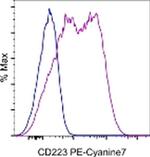
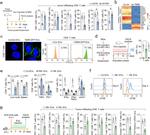
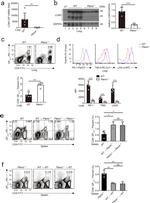
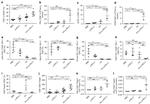
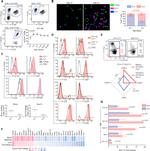
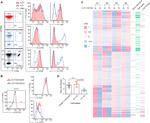
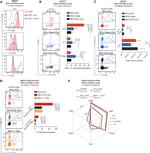

产品信息
25-2231-82
种属反应
已发表种属
宿主/亚型
分类
类型
克隆号
偶联物
激发/发射光谱
形式
浓度
纯化类型
保存液
内含物
保存条件
运输条件
RRID
产品详细信息
Description: The eBioC9B7W monoclonal antibody recognizes mouse CD223 (LAG-3, LAG3) protein expressed by activated alpha/beta-TCR bearing T cells, a subset of gamma/delta-TCR bearing T cells and a subset of NK cells. CD223 is a 70 kDa type I transmembrane protein with a structure that is similar to CD4. However, a soluble form of human CD223 has been detected by ELISA in human serum, and data suggest that mouse CD223 is proteolytically cleaved in the D4 domain. This results in a 54 kDa fragment containing all the extracellular domains, and a 16 kDa fragment containing the intracellular and transmembrane domains. The 54 kDa can remain membrane-associated or be released as soluble CD223.
CD223 binds to MHC class II with higher affinity than CD4, and it is thought that this interaction is involved in the negative regulation of T-cell activation and homeostatic proliferation. Furthermore, CD223 is expressed by CD4+CD25+ regulatory T cells, and it has been suggested that CD223 may be involved in their regulatory function.
Applications Reported: This eBioC9B7W (C9B7W) antibody has been reported for use in flow cytometric analysis.
Applications Tested: This eBioC9B7W (C9B7W) antibody has been tested by flow cytometric analysis of stimulated mouse splenocytes. This can be used at less than or equal to 1 µg per test. A test is defined as the amount (µg) of antibody that will stain a cell sample in a final volume of 100 µL. Cell number should be determined empirically but can range from 10^5 to 10^8 cells/test. It is recommended that the antibody be carefully titrated for optimal performance in the assay of interest.
Light sensitivity: This tandem dye is sensitive to photo-induced oxidation. Please protect this vial and stained samples from light.
Fixation: Samples can be stored in IC Fixation Buffer (Product # 00-8222) (100 µL of cell sample + 100 µL of IC Fixation Buffer) or 1-step Fix/Lyse Solution (Product # 00-5333) for up to 3 days in the dark at 4°C with minimal impact on brightness and FRET efficiency/compensation. Some generalizations regarding fluorophore performance after fixation can be made, but clone specific performance should be determined empirically.
Excitation: 488-561 nm; Emission: 775 nm; Laser: Blue Laser, Green Laser, Yellow-Green Laser.
Filtration: 0.2 µm post-manufacturing filtered.
靶标信息
LAG-3 is a 70-kDa surface glycoprotein belonging to the Ig superfamily with homology to CD4. LAG-3 binds to MHC class II with higher affinity than CD4 and is thought to be involved in the negative regulation of T cell activation and homeostatic proliferation. Surface expression of LAG-3 has been reported on activated T cells (including regulatory T cells) and NK cells. CD8+ T cells usually express LAG-3 at significantly higher levels than CD4+ T cells. Coexpression of LAG-3 and CD49b has been proposed to identify human and mouse Type 1 regulatory T cells (Tr1 cells).
仅用于科研。不用于诊断过程。未经明确授权不得转售。
How to use the Panel Builder
Watch the video to learn how to use the Invitrogen Flow Cytometry Panel Builder to build your next flow cytometry panel in 5 easy steps.
生物信息学
蛋白别名: Activation-induced cytidine deaminase-linked autoimmunity protein; Aida; CD223; LAG-3; Lymphocyte activation gene 3 protein; sLAG 3; sLAG3; soluble LAG 3lymphocyte activating 3; soluble LAG3
基因别名: CD223; LAG-3; Lag3; Ly66
UniProt ID: (Mouse) Q61790
Entrez Gene ID: (Mouse) 16768




